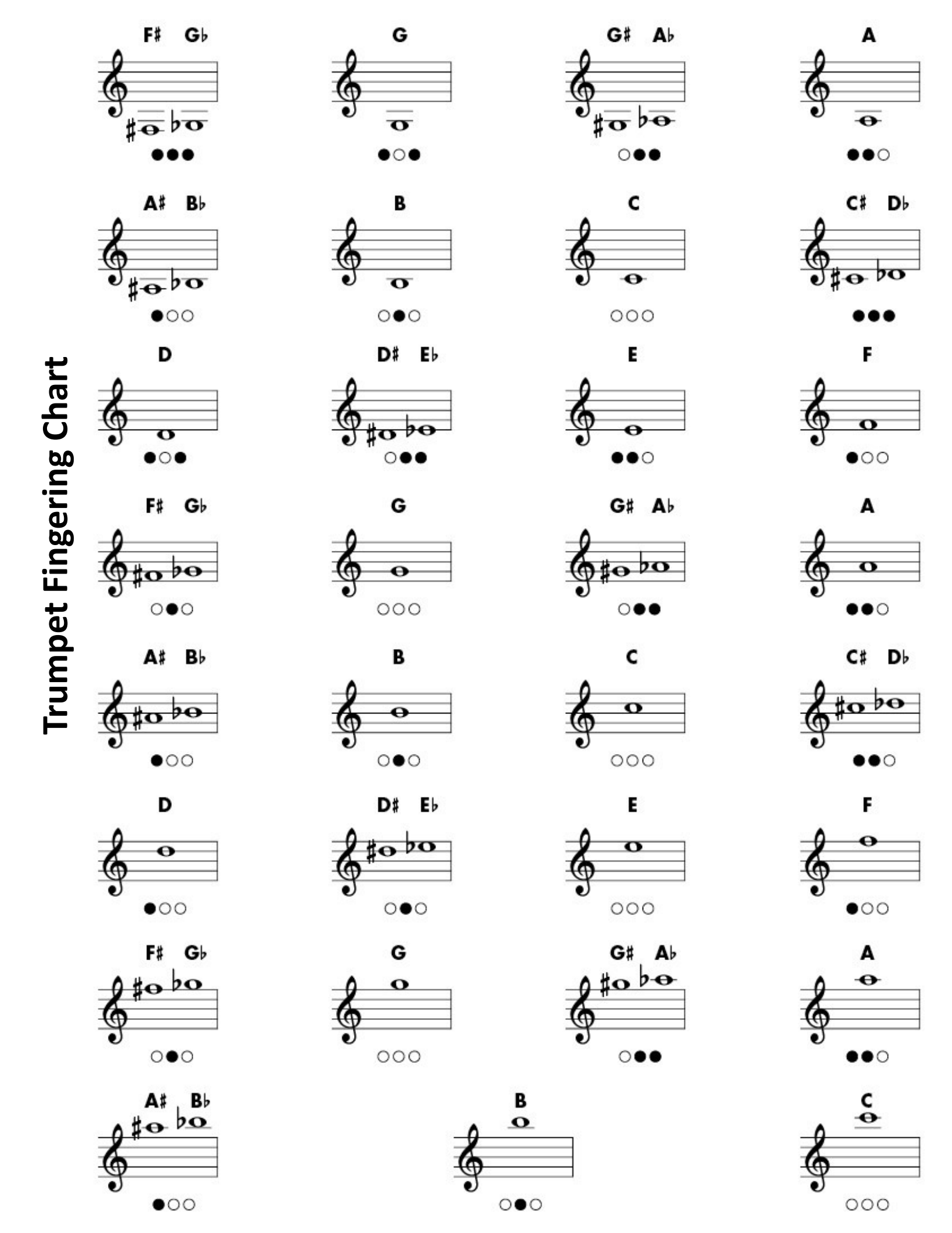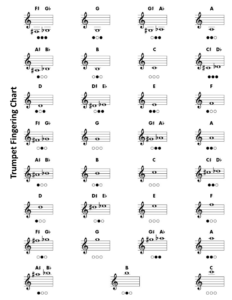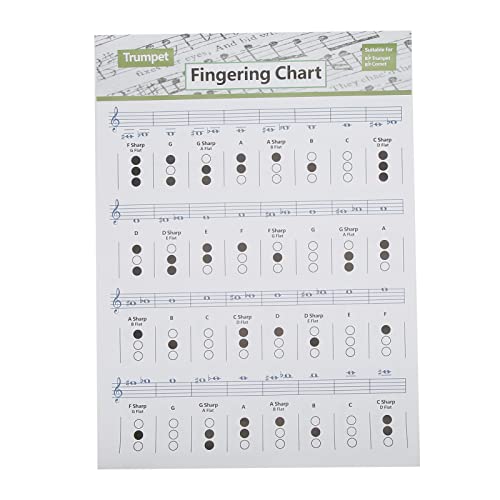Greetings, trumpet enthusiasts! Are you ready to take your playing to the next level? Then it’s time to dive into the trusty trumpet fingering charts, and why they can be so helpful to elevate your playing.
Getting a handle on your finger placement is crucial for playing the trumpet like a pro. After all, you wouldn’t drive a car without knowing how to use the pedals, right?
So, what exactly is a trumpet fingering chart and why do you need one?
Table of Contents
- What is a Trumpet Fingering Chart?
- Why You Need a Trumpet Fingering Chart
- Understanding the Fundamentals of Trumpet Fingerings
- Reaping the Benefits of a Trumpet Fingering Chart
- The Final Note: Putting Your Trumpet Fingering Chart to Use
- FAQs
What is a Trumpet Fingering Chart?
Simply put, a trumpet fingering chart is a guide that shows you where to place your fingers on the trumpet to produce different notes.
Think of it as a roadmap for your fingers. By following the chart, you’ll be able to play with confidence and accuracy, instead of fumbling around like a new driver on the road.
Why You Need a Trumpet Fingering Chart
Without a proper fingering chart, you may end up with sour notes or incorrect finger placement, which can negatively impact your overall sound quality.
On the other hand, using a fingering chart can help you play with better intonation, consistency, and accuracy. Plus, it can help you learn to play faster and with more agility.
In short, a trumpet fingering chart is like a trusty wingman for your fingers. So, without further ado, here’s a trumpet fingering chart that will get you on the right track with your trumpet skills.
P.S.: If you’re looking to pick up a hard copy of a trumpet fingering chart to keep with you, here are some handy options that we’d highly recommend.
PMV Top Pick – This trumpet fingering chart in particular, with its color-coded notes, makes things way, way easier as you’re learning.
- Chord Chart: This chord reference chart gives clear indication of trumpet fingering and notes on stave.
- Easier Study: Clear music notation will help practice as well as memorizing, making the learning easier.
- TRUMPET FINGERING CHART: Memorizing the notes on the fretboard can be daunting at first. Learn trumpet technique and master the trumpet with this fingering chart for all levels.
- COLOR-CODED NOTES: This trumpet fingering chart features color-coded notes to help beginners remember the finger positions. The easy-to-follow design makes this trumpet fingering chart convenient, especially for visual learners.
- Centerstream (Author)
- English (Publication Language)

Understanding the Fundamentals of Trumpet Fingerings
Let’s start with a quick overview of the basics of trumpet fingerings.
The Anatomy of a Trumpet
To fully understand trumpet fingerings, it’s important to know the different parts of the trumpet and how they work together.
A trumpet has three main components: the mouthpiece, the valves, and the tubing. Your lips vibrate against the mouthpiece to produce sound, while the valves determine the pitch by redirecting the air flow through different lengths of tubing.
In other words, the mouthpiece is where the magic happens, while the valves are like the DJ of the trumpet world, mixing things up and changing the tunes.
How Trumpet Fingerings are Determined
The combination of valve usage and lip buzzing is what creates the different pitches on the trumpet.
Trumpet fingerings are determined by which valves are used and in what order. For example, playing a C with the first valve will produce a different sound than playing a C with the first and third valves.
Think of it like a code, with each valve press representing a different letter. By knowing the code, you can play any song you want on the trumpet.
Speaking of all this trumpet anatomy, we’ve been talking all about trumpet fingering charts, while you may not have even picked up your actual trumpet yet!
Check out our PMV Top Pick below, plus some of the other bestselling options out there if you need a good starting point.
PMV Top Pick – This trumpet is our favorite, thanks to the trusted brand name, the thousands of solid reviews from players of all types, and the full slate of accessories that comes with it.
- Great Trumpet for Beginners: Ideal for beginner or student musicians. This student trumpet has a copper lead (not the metal lead, but leading up to it) mouthpiece, is topped with 3 comfortable mother-of-pearl inlaid keys and 3 smooth action valves.
- ❤️AMAZING TIMBRE — The sound and timbre of Eastar Bb trumpet are pure and bright, abundant and powerful, with excellent vibration. Also a user-friendly brass instrument for beginners and students.
Reaping the Benefits of a Trumpet Fingering Chart
Alright, folks, it’s time to talk about why using a trumpet fingering chart is worth your time and effort.
The Benefits of Proper Trumpet Fingering
Using a fingering chart can improve your playing in a number of ways.
For starters, it can help you play with better accuracy and consistency. No more guessing which valve to use, or hitting the wrong note.
Proper fingering also leads to better intonation, which is the musical term for playing in tune. With the right finger placement, you’ll sound more harmonious and in-sync with the rest of the band.
And let’s not forget about speed and agility. By using a fingering chart, you’ll be able to play faster and with more fluidity, making those tricky passages a breeze.
In short, using a trumpet fingering chart is like putting your fingers on the fast track to success.
On a related note, remember to score a couple of instructional trumpet books too if you’re just starting out with playing. Once you get the proper fingerings down, using the defined structure of a good instructional book is always a great next step for a new player.
[PRO TIP: Find an instructional trumpet book that includes duets and trios, so you can practice and improve with others. This trumpet book fits the bill.]
The Final Note: Putting Your Trumpet Fingering Chart to Use
Now you’re equipped with a helpful trumpet fingering chart to ramp up your practice, and you know the benefits that it can bring.
So what’s next?
Putting Your Chart to Use
The best way to get the most out of your trumpet fingering chart is to use it regularly. Make it a habit to reference the chart whenever you’re practicing or playing a new piece.
Don’t be afraid to experiment with different fingerings and see what works best for you. The more you use your chart, the more you’ll understand the fingerings and how they impact your sound.
Get Creative with Your Chart
You don’t have to limit yourself to just playing the notes as written. Get creative and see how you can use the fingerings to express yourself musically.
For example, you could try playing a phrase in a different octave or with a different rhythm. The possibilities are endless!
Keep Practicing, Keep Improving
Remember, practice makes perfect! The more you use your trumpet fingering chart, the better you’ll get at playing the trumpet.
So, don’t be discouraged if you don’t see results right away. Keep at it, and soon you’ll be playing those difficult passages with ease and sounding better than ever.
And with that, we come to the end of our trumpet fingering chart guide. We hope you’ve found it helpful and informative, and we can’t wait to hear all the beautiful music you’ll be making with your chart!
FAQs
What is a trumpet fingering chart?
A trumpet fingering chart is a tool used by trumpet players to help them learn and remember the correct fingerings for each note on the instrument.
Who can benefit from using a trumpet fingering chart?
Anyone who is learning to play the trumpet, from beginners to experienced players, can benefit from using a trumpet fingering chart.
What should I look for in a trumpet fingering chart?
You should look for a chart that is appropriate for your skill level, covers all the notes and fingerings you need, and is easy to read and understand.
Do all trumpet fingering charts cover the same notes and fingerings?
No, not all trumpet fingering charts are the same. Some may have more limited coverage, while others may include more advanced fingerings.
Is it important to use the right fingerings for each note on the trumpet?
Yes, using the correct fingerings is essential for producing a good sound on the trumpet and playing in tune.
Can I use a trumpet fingering chart while playing music, or do I need to memorize all the fingerings first?
You can use a chart while playing, and it’s perfectly normal to refer to it as you practice or play new pieces. You don’t need to memorize all the fingerings first.
Can I create my own trumpet fingering chart, or do I need to purchase one?
You can create your own chart if you like, but many players find it helpful to use a pre-made chart for convenience and ease of use.
Can I use a trumpet fingering chart to help me play in different keys?
Yes, you can use a chart to help you play in different keys. Just make sure to choose a chart that includes the fingerings for the key you’re playing in.
Are there different types of trumpet fingering charts available?
Yes, there are different types of charts available, including beginner charts, advanced charts, and charts designed for specific types of music.
How often should I use my trumpet fingering chart while practicing?
It’s a good idea to use your chart regularly while practicing, and especially when learning new pieces. This will help you get the most out of your chart and improve your playing faster.






